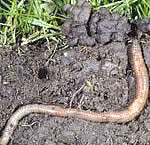
Interactions
Beetles are not the only organisms
that inhabit the very resourceful dung pats. In fact, dung
pats are colonized by many other organisms and they all aid in
the decomposition of the dung. These other organisms can
include: flies, predatory beetles, earthworms, nematodes, mites,
bacteria, and fungi (Menendez and
Gutierrez 1999). This diversity of dung beetles on
dung pats is possible due to the different successional
occurrences of the different species of dung beetles (Sladecek
et al. 2013). The diversity of organisms of belonging
to different families is a result of what part of the dung the
organism feeds on. For example, A. prodromus beetles feed
on wetter dung so they will arrive earlier (Sladecek
et al. 2013), while earthworms are able to get nutrients
from older, not as fresh, dung, so they arrive later
(Menendez and Gutierrez 1999).
The first organisms to usually get to
the fresh dung piles are
flies, and shortly after are the dung
beetles. Because of the increase of dung beetles, the next
organisms to arrive are indeed predatory beetles. This can
include, but is not limited to, beetles from the family
Staphylinidae. After the arrival of predatory beetles, organisms such as earthworms, nematodes, mites, fungi, and bacteria
move in (Menendez and Gutierrez 1999).
These organisms are ones that can live in a wide variety of
environments and are able to use many resources from these different
environments in order to survive. Earthworms are very helpful
in decomposition of dung in two ways: directly and indirectly.
Directly simply by using it as a food source and ingesting and
ridding of the dung, and indirectly through acts such as
simply breaking the harder crust of the dung and exposing it to
weathering (Holter 1979). A.
prodromus, many other dung beetles, and even completely different
organisms all, unknowingly, work together to aid in the
decomposition of dung!!
organisms such as earthworms, nematodes, mites, fungi, and bacteria
move in (Menendez and Gutierrez 1999).
These organisms are ones that can live in a wide variety of
environments and are able to use many resources from these different
environments in order to survive. Earthworms are very helpful
in decomposition of dung in two ways: directly and indirectly.
Directly simply by using it as a food source and ingesting and
ridding of the dung, and indirectly through acts such as
simply breaking the harder crust of the dung and exposing it to
weathering (Holter 1979). A.
prodromus, many other dung beetles, and even completely different
organisms all, unknowingly, work together to aid in the
decomposition of dung!!
There are many benefits that come from decomposing dung material. This process begins a series of ecosystem functions, in which provide beneficial services. Some of these services can include, but are not limited to, soil fertilization and growth of plant species.
Soil fertilization results from the act of dung beetles
conserving nitrogen. Instead of the nitrogen from the dung
escaping into the atmosphere, the process of Aphodius spp. burying
the dung ensures that that the nitrogen will stay in the soil, thus
allowing plants to have access to more nitrogen. Nitrogen is a
key factor in plant growth so plants are very thankful to these beetles
for the supply! This can play a key role in keeping plants,
such as grasses, present in animal pastures.
factor in plant growth so plants are very thankful to these beetles
for the supply! This can play a key role in keeping plants,
such as grasses, present in animal pastures.
Unfortunately, a downside to this wonderful dung eating species:
It is possible that dung beetles, including A. prodromus, can also be carriers of parasites, spreading diseases to the very animals that supply them with the dung (Nichols et al. 2008).